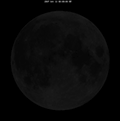The Frequency of the Synodic Moon

The synodic period of the moon is the mean duration of a lunar phase cycle from one new moon to the following new moonm, or from one full moon to the next. The lunar phase cycle is variable and is called a lunation. From one synodic lunar revolution to the next, the difference can be over 3 hours, and in the course of some years of a decade, over 13 hours. The calculated average of currently about 29.53 days is called a synodic month.
Duration: 29.530588 days
Tone: 210.42 Hz = G# (29. octvave)
a1 = 445.9 Hz / 440 Hz + 22.9 cent)
![]() Sample
Sample
Tempo: 98.6 bpm (22. octave)
Color: orange (70. octave)
From "The Cosmic Octave Tuning Forks" by Hans Cousto:
Chakra: Svadisthana - navel chakra
Effect: stimulates sexual energy, supports erotic communication, (medicinal: for woman it is good for regulation of menstration, in general disturbances of gland and lymph system)
The word "synod" means coming together. The synodic month is the middle period from one new moon to the next. At new moon the sun is in cunjunction with the moon (the same direction in the sky). The calendar month is derived from the synodic month. In the 29th octave the moon oscillates with 210.42 Hz, wich is a G#. The corresponding colour is an orange with a wavelength of about 650 Nanometer.
Women know much better then men, how strong sexual rhythms are related to the moon. Every month there is menstruation. The sexual life of many species on earth and not only human beings is directed by the moon. Moon and sexuality are very closely related.
At full moon, when sun is in opposition to the moon people are more ready to communi-cate and more vivid than at new moon. For that reason great feasts are in many cultures celebrated at full moon. The Passover of the Jews, the Holy festival or Guru Purnima of India, all those feasts are alway celebrated at full moon. Originally Easter was celebrated at full moon by the Christians until the Council of Nicaea decreed in the year 325 that this feast of Resurrection should always be celebrated with the waning moon. Surely you have also celebrated at full moon at one time or another in some capacity.
The tone of the moon is very suitable for meditation music at occasions like full moon rituals. This tones improves general and especially sexual communication.
In therapy the tone of the moon is most of all used with disturbances of the gland and lymph system and also disturbances of menstruation. There are lots of points, that can be treated with the tone of the moon, wich cannot all be listed here. By all means the 3rd coccygeal (point 2 of the Du-Mai-Meridian) is very suitable, because it corresponds to the 2nd chakra, wich is the Svadis-than chakra. At this place it is to be pointed out distinctly that tonepuncture is supporting therapy but can never replace visiting a doctor. All serious complaints should be treated by a doctor and one should not believe that all disturbances can removed with tuning fork. Tonepuncture often supports medical treatment and helps one to recover quickly as it stimulates the flow of the energies.
The Cosmic Octave Tuning Forks by Hans Cousto is licensed unter
CC BY-NC-ND 4.0
